Basic Information
-
mRNA expression analysis

-
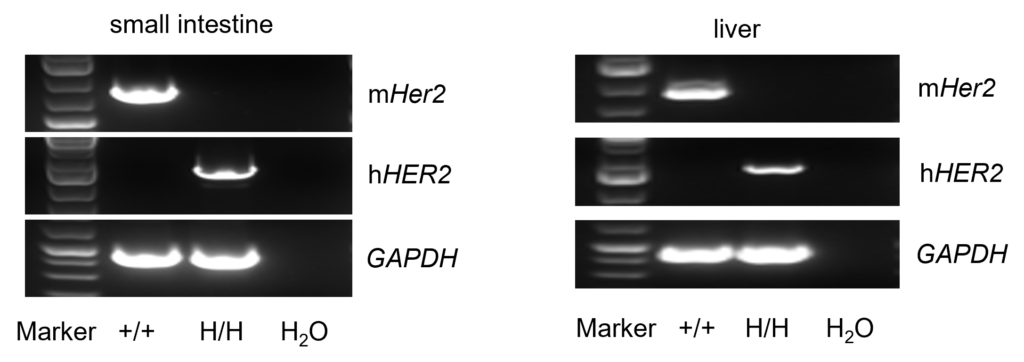
Species-specific HER2 gene expression analysis in wild-type and humanized B-hHER2 mice by RT-PCR. Mouse Erbb2 mRNA was detected in small intestine and liver tissues from wild-type C57BL/6 (+/+) mice, while human ERBB2 mRNA was detected in homozygous B-hHER2 (H/H) mice.
-
IHC analysis of HER2 expression

-
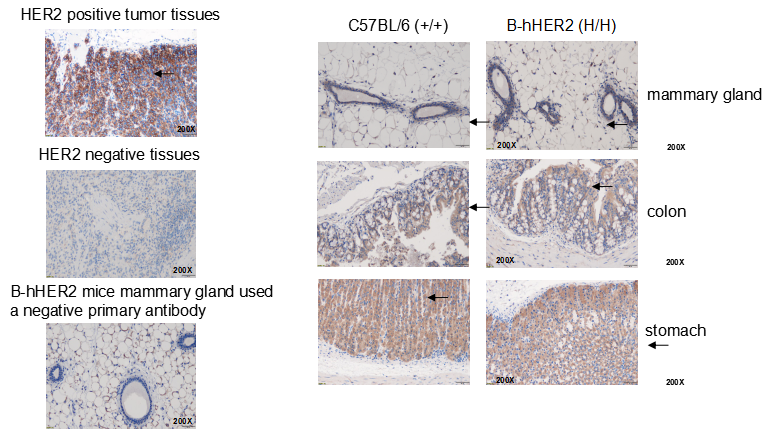
Immunohistochemical (IHC) analysis of HER2 expression in humanized B-hHER2 mice. Mammary gland, colon and stomach tissues were collected from wild-type C57BL/6 (+/+) and homozygous B-hHER2 (H/H) mice and analyzed by IHC using an anti-Her2 antibody. HER2 was detected in wild-type and homozygous B-hHER2 mice due to the cross-reactivity of the antibody. The arrow indicates tissue cells with positive HER2 staining (brown).
-
Analysis of spleen immune cells in B-hHER2 mice

-

Analysis of spleen leukocyte subpopulations in humanized B-hHER2 mice. Splenocytes were isolated from wild-type C57BL/6 (+/+) and homozygous B-hHER2 (H/H) mice (female, n=3, 9-week-old), and analyzed by flow cytometry to assess splenic leukocyte subpopulations. (A) Representative flow cytometry plots. Single live cells were gated on CD45 and used for further analysis as indicated. (B) Percent of T cells, B cells, NK cells, dendritic cells, granulocytes, monocytes and macrophages in homozygous B-hHER2 mice were similar to those in wild-type mice, demonstrating that introduction of hHER2 in place of its mouse counterpart does not change the overall development, differentiation or distribution of splenic leukocytes. Values are expressed as mean ± SEM.
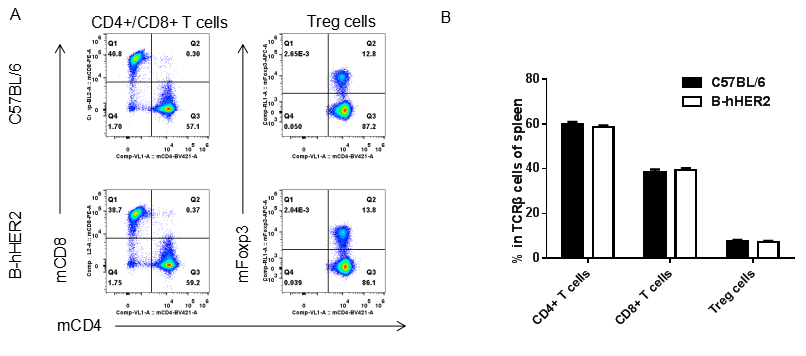
Analysis of spleen T cells in humanized B-hHER2 mice. Splenocytes were isolated from wild-type C57BL/6 (+/+) and homozygous B-hHER2 (H/H) mice (female, n=3, 9 week-old), and analyzed by flow cytometry to assess splenic T cell subpopulations. (A) Representative flow cytometry plots. Single live CD45+ cells were gated on CD3 and used for further analysis as indicated. (B) Percent of CD8+ T cells, CD4+ T cells and Tregs in homozygous B-hHER2 mice were similar to those in wild-type mice, demonstrating that introduction of hHER2 in place of its mouse counterpart does not change the overall development, differentiation or distribution of splenic T cell subtypes. Values are expressed as mean ± SEM.
-
Analysis of lymph node immune cells in B-hHER2 mice

-
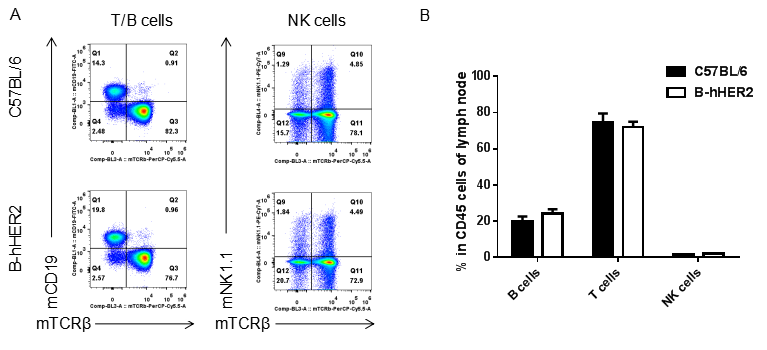 Analysis of lymph node leukocyte subpopulations in humanized B-hHER2 mice. Leukocytes were isolated from wild-type C57BL/6 (+/+) and homozygous B-hHER2 (H/H) mice (female, n=3, 9 week-old), and analyzed by flow cytometry to assess lymph node leukocyte subpopulations. (A) Representative flow cytometry plots. Single live cells were gated on CD45 and used for further analysis as indicated. (B) Percent of T cells, B cells and NK cells in homozygous B-hHER2 mice were similar to those in wild-type mice, demonstrating that introduction of hHER2 in place of its mouse counterpart does not change the overall development, differentiation or distribution of lymph node leukocytes. Values are expressed as mean ± SEM.
Analysis of lymph node leukocyte subpopulations in humanized B-hHER2 mice. Leukocytes were isolated from wild-type C57BL/6 (+/+) and homozygous B-hHER2 (H/H) mice (female, n=3, 9 week-old), and analyzed by flow cytometry to assess lymph node leukocyte subpopulations. (A) Representative flow cytometry plots. Single live cells were gated on CD45 and used for further analysis as indicated. (B) Percent of T cells, B cells and NK cells in homozygous B-hHER2 mice were similar to those in wild-type mice, demonstrating that introduction of hHER2 in place of its mouse counterpart does not change the overall development, differentiation or distribution of lymph node leukocytes. Values are expressed as mean ± SEM.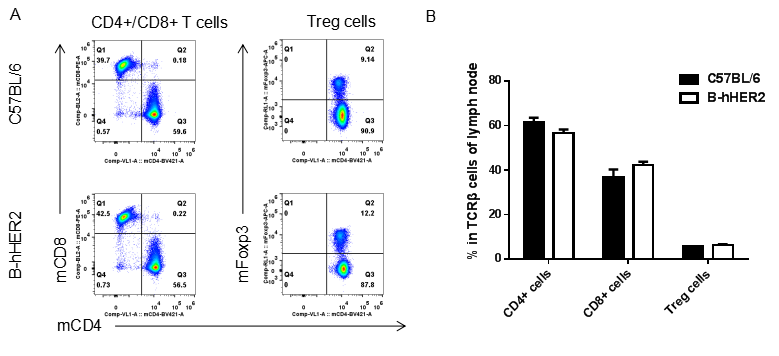 Analysis of lymph node T cells in humanized B-hHER2 mice. Leukocytes were isolated from wild-type C57BL/6 (+/+) and homozygous B-hHER2 (H/H) mice (female, n=3, 9 week-old), and analyzed by flow cytometry to assess lymph node T cell subpopulations. (A) Representative flow cytometry plots. Single live CD45+ cells were gated on CD3 and used for further analysis as indicated. (B) Percent of CD8+ T cells, CD4+ T cells and Tregs in homozygous B-hHER2 mice were similar to those in wild-type mice, demonstrating that introduction of hHER2 in place of its mouse counterpart does not change the overall development, differentiation or distribution of lymph node T cell subtypes. Values are expressed as mean ± SEM.
Analysis of lymph node T cells in humanized B-hHER2 mice. Leukocytes were isolated from wild-type C57BL/6 (+/+) and homozygous B-hHER2 (H/H) mice (female, n=3, 9 week-old), and analyzed by flow cytometry to assess lymph node T cell subpopulations. (A) Representative flow cytometry plots. Single live CD45+ cells were gated on CD3 and used for further analysis as indicated. (B) Percent of CD8+ T cells, CD4+ T cells and Tregs in homozygous B-hHER2 mice were similar to those in wild-type mice, demonstrating that introduction of hHER2 in place of its mouse counterpart does not change the overall development, differentiation or distribution of lymph node T cell subtypes. Values are expressed as mean ± SEM. -
Analysis of blood immune cells in B-hHER2 mice

-

Analysis of blood leukocyte subpopulations in humanized B-hHER2 mice. Blood cells were isolated from wild-type C57BL/6 (+/+) and homozygous B-hHER2 (H/H) mice (female, n=3, 9 week-old), and analyzed by flow cytometry to assess blood leukocyte subpopulations. (A) Representative flow cytometry plots. Single live cells were gated on CD45 and used for further analysis as indicated. (B) Percent of T cells, B cells, NK cells, dendritic cells, granulocytes, monocytes and macrophages in homozygous B-hHER2 mice were similar to those in wild-type mice, demonstrating that introduction of hHER2 in place of its mouse counterpart does not change the overall development, differentiation or distribution of blood leukocytes. Values are expressed as mean ± SEM.

Analysis of blood T cell subpopulations in humanized B-hHER2 mice. Blood cells were isolated from wild-type C57BL/6 (+/+) and homozygous B-hHER2 (H/H) mice (female, n=3, 9 week-old), and analyzed by flow cytometry to assess blood T cell subpopulations. (A) Representative flow cytometry plots. Single live CD45+ cells were gated on CD3 and used for further analysis as indicated. (B) Percent of CD8+ T cells, CD4+ T cells and Tregs in homozygous B-hHER2 mice were similar to those in wild-type mice, demonstrating that introduction of hHER2 in place of its mouse counterpart does not change the overall development, differentiation or distribution of blood T cell subtypes. Values are expressed as mean ± SEM.
-
Blood routine test in B-hHER2 mice

-

Complete blood count (CBC).
Blood from female C57BL/6 and B-hHER2 mice (n=8, 8-week-old) was collected and analyzed for CBC. There was no differences among any measurement between C57BL/6 and B-hHER2 mice, indicating that introduction of hHER2 in place of its mouse counterpart does not change blood cell composition and morphology. Values are expressed as mean ± SEM.
-
Blood biochemistry of B-hHER2 mice

-

Blood biochemistry tests of B-hHER2 mice.
Serum from the C57BL/6 and B-hHER2 mice (n=8, 8-week-old) was collected and analyzed for levels of ALT and AST. There was no differences on either measurement between C57BL/6 and B-hHER2 mice, indicating that introduction of hHER2 in place of its mouse counterpart does not change ALT and AST levels or health of liver. Values are expressed as mean ± SEM.
-
Toxicity evaluation in B-hHER2 mice

-
Case 1
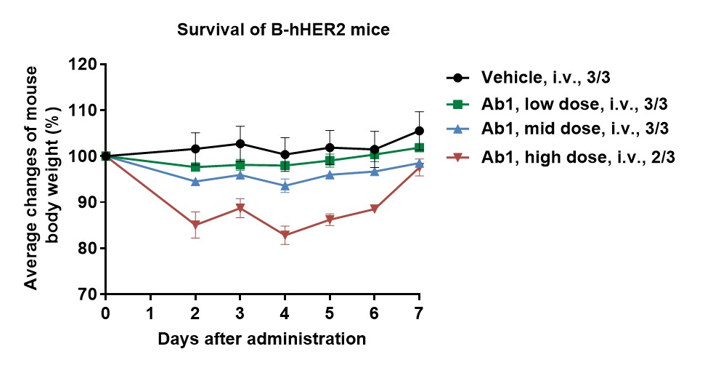
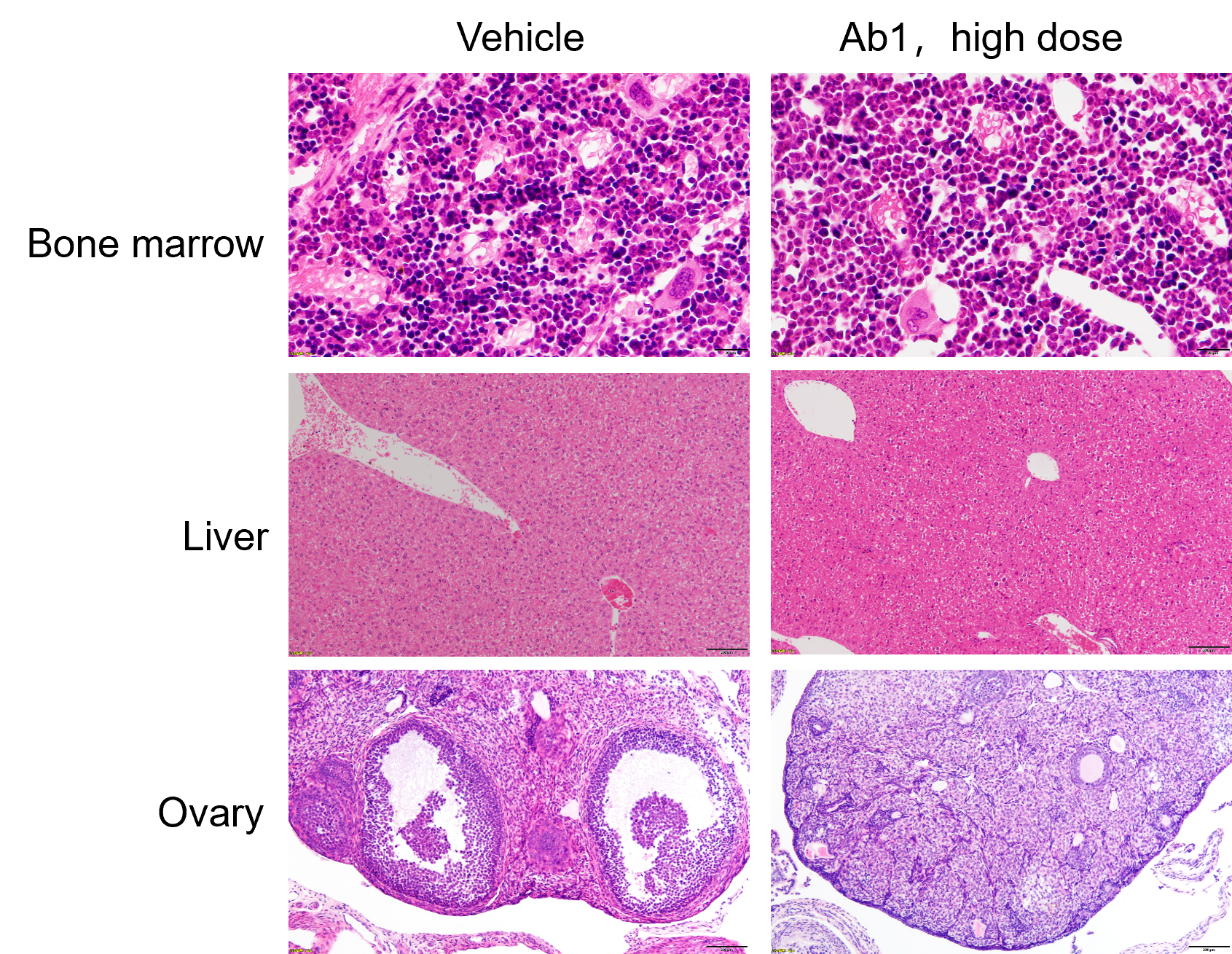
Different doses of anti-human HER2 antibody Ab1 were injected into B-hHER2 mice via a single intravenous injection. The body weight of B-hHER2 mice decreased in a dose-dependent manner. In the high-dose group, one mouse died. Histopathological analysis revealed no significant abnormal changes in liver, but no immature follicles were seen in ovaries, and the myeloid cells in the bone marrow increased and the red blood cell count decreased. This suggests that B-hHER2 mice can be used to assess the toxicity of anti-human HER2 antibodies. Data is obtained from a partner. Values are expressed as mean ± SEM.
Case 2
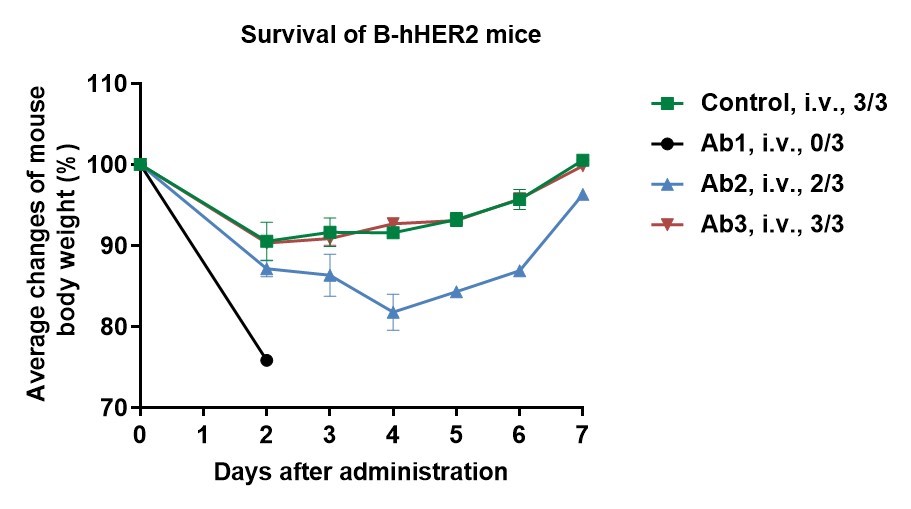
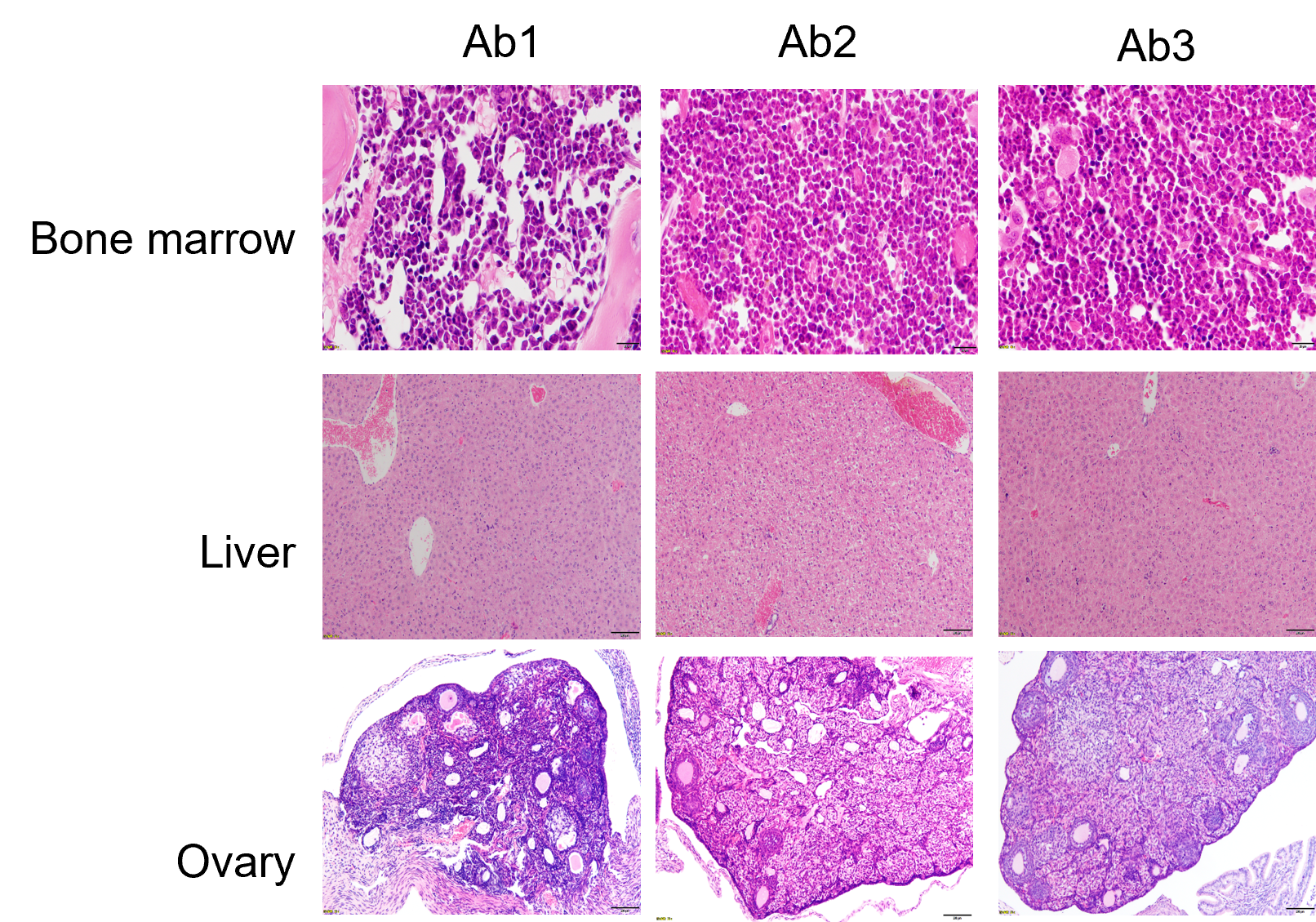
Different anti-human HER2 antibodies were injected into B-hHER2 mice through a single intravenous injection. The mice in different antibody treatment groups had varying rates of weight loss. In antibody Ab1 treatment group, all mice were euthanized due to rapid weight loss. Mild toxicity was observed in the bone marrow and ovaries through histopathological analysis. This suggests that B-hHER2 mice can be used to assess the toxicity of anti-human HER2 antibodies. Data is obtained from a partner. Values are expressed as mean ± SEM.


